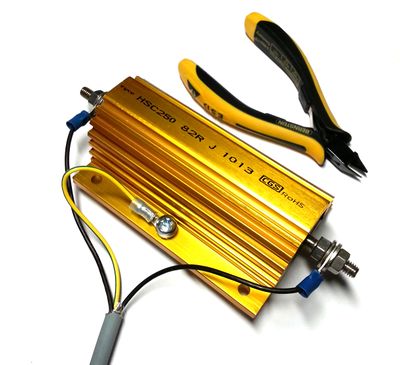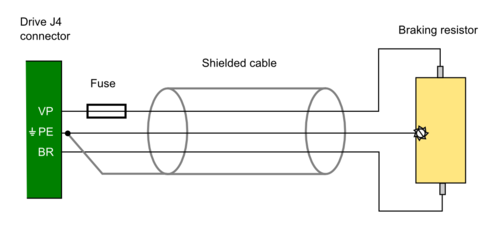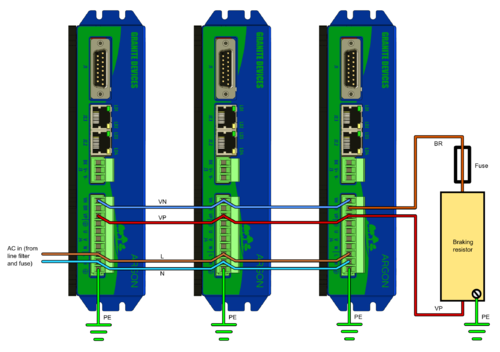Difference between revisions of "Argon user guide/Braking resistor"
| [checked revision] | [checked revision] |
| Line 4: | Line 4: | ||
Argon supports connecting braking resistor directly to drive [[Argon_wiring#J3_24V_power_and_motor_brake_port|J4 connector]]. | Argon supports connecting braking resistor directly to drive [[Argon_wiring#J3_24V_power_and_motor_brake_port|J4 connector]]. | ||
| + | {{tip|Braking resistor is not always necessary. It is safe to test and use drive without braking resistor as drive will protect it self against overvoltage. If overvoltage faults occur during normal operation or during motor deceleration, add braking resistor to the system.}} | ||
==Suitable resistor type== | ==Suitable resistor type== | ||
Characteristics of Argon regenerative resistor output: | Characteristics of Argon regenerative resistor output: | ||
Revision as of 22:13, 27 January 2014
Regenerative resistors are usually a required part with servo drives to absorb returned energy from decelerating or braking servo axis.Servo drive with motor can act two ways: energy supply and energy generator. The generator behavior occurs during decelerations and this causes current flow from motor to drive power supply capacitors. If that generated energy is not absorbed anywhere, the voltage of capacitors will rise above overvoltage threshold and trigger an software clearable overvoltage fault.
Argon supports connecting braking resistor directly to drive J4 connector.
| Braking resistor is not always necessary. It is safe to test and use drive without braking resistor as drive will protect it self against overvoltage. If overvoltage faults occur during normal operation or during motor deceleration, add braking resistor to the system. |
Suitable resistor type
Characteristics of Argon regenerative resistor output:
| Property | Value | Units |
|---|---|---|
| Maximum current | 6 | A |
| Series fuse | 8 | A |
| Minimum allowed resistance @ 230 VAC supply | 63 | Ω |
| Minimum allowed resistance @ 115 VAC supply | 35 | Ω |
| Resistor power dissipation | 0-2400¹ | W |
¹) Power dissipation depends on how much system's kinetic energy is directed to the resistor
Recommended resistor specifications:
- Resistance 80-100 ohms @ 220-240 VAC
- Resistance 40-50 ohms @ 110-120 VAC
- Power rating 150-300 Watts, this may greatly vary depending on how much energy the braking resistor must absorb
- Wire wound construction (no film resistors unless high peak energy capable)
- Preferrable in metal housing for grounding/noise shielding
The 250W resistor in the image can absorb enough peak energy to stop 100 kg mechanical linear axis moving up to 3 m/s.
Example of suitable resistor for most 220-240 VAC installations: Tyco HSC 250 82R (data sheet pdf).
Installation
The image aside shows proper wiring of braking resistor. Proper installation has:
- Shielded cable with 3 conductors with wire gauge at least 0.75 mm² / 18 AWG
- Cable shield AND earth conductor connected to drive PE terminal
- Earth conductor connected to resistor casing. Place toothed locking washers between wire terminal and resistor to break the insulating coating of resistor case.
- Two other conductors connected to resistor terminals through 8A fast blow fuse
- Resistor should be also mounted on heat sink
- Additionally it is a recommended to shield the resistor terminals from accidental touching
Resistor sharing
It is possible to share HV DC link between Argon drives to reduce number of braking resistors needed. Sharing DC bus also forms a higher power HV DC supply between the drives allowing higher power drawn from a single drive if other drives are running on lighter load.
| The terminals of the resistors are connected to dangerous voltages. Never touch them before drive power has been safely discharged. |


